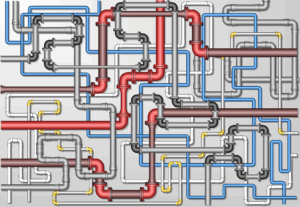With a strong framework, the business can take a more competitive approach to idea generation. These ideas can then be more easily turned into options for executives to consider. There are many different types of innovation frameworks that a company can leverage. “There are many frameworks for tackling different types of problems in different contexts, and those collectively help you to innovate,” says Samina Karim, professor of entrepreneurship and innovation at Northeastern’s D’Amore-McKim School of Business.
Common Innovation Frameworks
Northeastern University’s article, “Popular Innovation Frameworks and How to Use Them,” examines some of the more common innovation framework systems in the context of mergers and acquisitions. These can work for a variety of industries and provides structure to the innovation and ideation process, giving the team ways to weigh and evaluate their options.
The first framework revolves around the question of whether a company should focus on partnerships versus acquisitions. The pros and cons need to be evaluated for each avenue forward. “To successfully create value from other firms, whether through an alliance or acquisition, businesses must first ask themselves what they hope to get from the other company, what kinds of resources are at stake, and what the market looks like,” the article states.
A second framework revolves around what is called the new merger and acquisition playbook. In other words, if a firm has been acquired, just how will it be integrated, or not, into your operations? “It seems like a simple question, but the framework breaks this down into two ideas,” Karim says. “Are you acquiring something so that you continue to do what you do, but do it better, or is it that you really want to do something new and different than what you already do?”
The Three Horizons framework follows, with an emphasis on how to sustain growth and improve performance. According to Northeastern University, the first horizon represents the core products or services that have the highest levels of consumer recognition and profits. The second horizon consists of emerging opportunities that may need investments to reach their profit potential, and the third is made up of ideas for profitable growth that will take longer to generate results.
Another popular framework to establish new markets is known as Blue Ocean. This postulates that red oceans are markets already in existence and represent most industries with defined and accepted boundaries. Blue oceans, on the other hand, are largely untapped markets, where companies can expand by creating their own demand. “Organizations seeking to adapt the blue ocean framework for their own use can consider how to best use their current business practices, products, and services in new markets, leveraging their expertise for unique purposes.”
Innovation Ventures
Innovation frameworks are often a key part of the research and development process. Yet, much of this process also revolves around the questions of corporate venturing and how the enterprise deals with start-ups and new ventures.
In All Things Innovation’s “Innovation Ventures,” Seth Adler discusses the subject with Chris Varley, Principal of Goodyear Ventures, The Goodyear Tire & Rubber Company. Varley states that, “Big companies develop bureaucracy because they need it. What happens though is a lot of rigidity creeps in, and that can kill innovation. So, smart companies start looking at how we can keep the bureaucracy that we need to function as a large organization – but find better, faster, cheaper ways to get new ideas in-house and in the market.” This would be the origin of how a partnership with startups and corporate ventures comes into fruition.
Research and development is a necessity for a business to thrive, however there are many bottlenecks and misconceptions that come with the process as a whole. One primary misconception that Varley touches on is the overall role of an R&D professional. He states that “the key is to enable the people in R&D to be gatekeepers and to understand that their role is to not necessarily to always invent everything, but to identify what the right things are.”
Testing, Testing
Innovation frameworks can be complex and there are numerous models to choose from. Before picking one for you and your team, it’s important to set goals and priorities while assessing the scope and scale of the project in question. We asked ChatGPT for a few fundamental tips in employing an innovation framework.
- Start small: Innovation frameworks are complex and can be overwhelming if you try to tackle them all at once. Start with one or two core ideas, then build out from there as needed.
- Set measurable goals: Make sure that the framework you choose has clear objectives so that progress can be tracked and reported on easily. This will help ensure that the project is moving forward in a meaningful way.
- Involve stakeholders early: Get key stakeholders involved in the process of developing an innovation framework early on so they understand how it works and can provide feedback throughout its development and implementation phases.
- Test and refine: Before launching your new framework, make sure to test it internally first before rolling it out to customers or clients for broader use cases – this will help identify any potential issues before they become larger problems down the line.
- Iterate and improve: As you gain more experience using your innovation framework, take time periodically to review what’s working well, what needs improvement, and how else it could be used effectively in different contexts or industries.
Growth Drivers
Even strong innovation teams, often with a cross functional focus, can strengthen their efforts through different types of innovation frameworks to drive growth. It is an effective way to vet ideas, evaluate pros and cons and make more educated decisions. It can also speed up the process of innovation. These systems can also help encourage and foster a culture of innovation. From disruptive and incremental innovation to other types of innovation processes, there are a diverse set of strategic frameworks that are designed depending upon need and scope. These systems can support the organization and set the best parameters, practices and processes for guiding your company on the way to their own “Blue Ocean” of potential profits.
Contributor
-

Matthew Kramer is the Digital Editor for All Things Insights & All Things Innovation. He has over 20 years of experience working in publishing and media companies, on a variety of business-to-business publications, websites and trade shows.
View all posts















































































































































